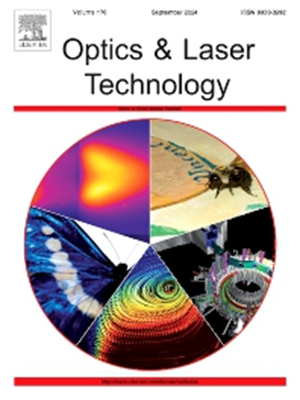A 48-tupling millimeter-wave re-modulation generation scheme based on a cascade of two DPMZMs
IF 4.6
2区 物理与天体物理
Q1 OPTICS
引用次数: 0
Abstract
In this paper, a filterless system based on a cascade of two DPMZMs is proposed to generate a frequency 48-tupling millimeter wave signal. A 5 GHz radio frequency (RF) signal drives two cascaded double parallel MZMs (DPMZM). In DPMZM-1, two Mach-Zehnder modulators (MZMs) connected in parallel are used to generate 40 GHz RF signals for re-modulation, and after a DC block to isolate the DC component generated by the beat frequency, it enters DPMZM-2 again for modulation, and the desired 48-tupling MMW signals can be obtained at the end. Based on the simulation results, the effects of non-ideal factors such as MZM extinction ratio (ER) and modulation coefficient deviation on the system’s stability are analyzed, and a tolerable range is given. Theoretical analysis and simulation experiments are carried out for the scheme proposed in this paper, and the experimental results show that the optical sideband suppression ratio (OSSR) and radio frequency sideband suppression ratio (RFSSR) are 25.6174 dB and 20 dB, respectively. The simulation results are consistent with the theoretical analysis, proving the scheme’s feasibility. In addition, the transmission performance of the system generating a 2.5 Gbps baseband signal modulated on an MMW signal over 10 km of optical fiber is also verified, with a loss of 0.4 dBm at a bit error rate of 10−9 compared to BTB transmission.
求助全文
约1分钟内获得全文
求助全文
来源期刊
CiteScore
8.50
自引率
10.00%
发文量
1060
审稿时长
3.4 months
期刊介绍:
Optics & Laser Technology aims to provide a vehicle for the publication of a broad range of high quality research and review papers in those fields of scientific and engineering research appertaining to the development and application of the technology of optics and lasers. Papers describing original work in these areas are submitted to rigorous refereeing prior to acceptance for publication.
The scope of Optics & Laser Technology encompasses, but is not restricted to, the following areas:
•development in all types of lasers
•developments in optoelectronic devices and photonics
•developments in new photonics and optical concepts
•developments in conventional optics, optical instruments and components
•techniques of optical metrology, including interferometry and optical fibre sensors
•LIDAR and other non-contact optical measurement techniques, including optical methods in heat and fluid flow
•applications of lasers to materials processing, optical NDT display (including holography) and optical communication
•research and development in the field of laser safety including studies of hazards resulting from the applications of lasers (laser safety, hazards of laser fume)
•developments in optical computing and optical information processing
•developments in new optical materials
•developments in new optical characterization methods and techniques
•developments in quantum optics
•developments in light assisted micro and nanofabrication methods and techniques
•developments in nanophotonics and biophotonics
•developments in imaging processing and systems

 求助内容:
求助内容: 应助结果提醒方式:
应助结果提醒方式:


